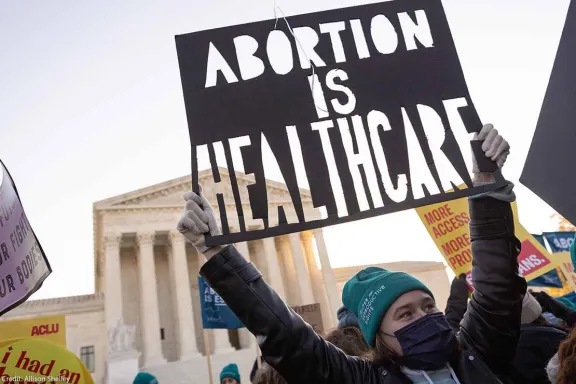
Community Partnerships and Transformative Legislature: The Route to Equitable Abortion Access
It has been nearly one and a half years since Roe V. Wade was overturned by Dobbs v. Jackson Women’s Health Organization in the Supreme Court, after standing as federal law for over 50 years, and people seeking abortions are experiencing the most harm yet.
The court proceedings of Roe V. Wade found that the “right to privacy” is protected by the penumbra of the 14th amendment of the Constitution, which was ratified in 1886, and the prevention of abortion is unconstitutional under the First, Fourth, Fifth, Ninth, and Fourteenth Amendments.
According to the supreme court ruling of Roe V. Wade in 1973, “this right of privacy . . . founded in the Fourteenth Amendment's concept of personal liberty and restrictions upon state action . . . is broad enough to encompass a woman’s decision whether or not to terminate her pregnancy.”
The resulting federal mandate was that during the first trimester, the choice to have an abortion was under the jurisdiction of the woman.
From 1973 to June 2022, this right stood across the country, however, when Roe V. Wade was overturned, the rights to abortion, privacy, and health were endangered for 22 million women in more than half of the states as declared by human rights experts within the United Nations (UN).
Today, abortion is completely illegal in 14 states, 10 more have expressed intentions to follow suit, and an additional three states and Puerto Rico have no protections set in law to protect the right to abortion.
The effects of these bans and structural barriers on maternal and reproductive health are grim and potentially life-threatening for those seeking abortion in unprotected areas. According to a modeling study performed from the 1990s to 2019, countries with strict abortion restrictions have higher rates of unintended pregnancies, and rates of abortion for these pregnancies are largely the same regardless of its legal status across nations.
In 2019, another study of 162 countries found that increased maternal mortality rates are associated with more restrictive abortion laws.
These studies weigh heavily on the implications for the health of people who seek abortions in 2023when the proportion of maternal deaths attributable to unsafe abortion is 13% globally, behind hemorrhage and hypertensive disorders.
These studies and statistics only begin to unearth the intricacies of maternal and reproductive health in the United States today. Black, Indigenous, and people of color, carry a disproportionate weight of the burden of diminished maternal health due to systemic and structural racism which contribute to worsened health outcomes.
Black, American Indian, and Alaska Native (AIAN) women have maternal mortality rates three and two times greater than white women respectively.
Compared to white women, Black, AIAN, Native Hawaiian and Other Pacific Islander (NHOPI) women also have historically higher proportions of low birthweight births, preterm births, and reduced or no prenatal care.
Compounding factors introduced by structural racism further exacerbate the barriers to maternal healthcare and abortion such as the increased likelihood of being uninsured, underinsured, far from healthcare centers, or having more unstable income or employment.
The UN has expressed that the right to abortion on a fundamental level is “pivotal to women’s enjoyment of a full spectrum of human rights.”
I believe the most holistic, effective way to uphold this human right is through policy and community partnership and engagement. The priorities of “availability, accessibility, affordability, acceptability and quality” regarding safe abortions must be represented in law, as well as prioritized reproductive education, however this improvement in a vacuum will not transform maternal health and security enough.
Abortion-focused policy must be supplemented by structural competency and community partnership. Structural competency takes the form of policies and systems, which mitigate the social determinants of health, and community partnership involves empowering community members in legislative bodies, authorship, and grass-roots health initiatives.
I agree that community members with lived experience are best able to assess and define health disparities as is the case with Black, AIAN, and NHOPI women receiving worse maternal care as a result of stratified levels of racism in healthcare. They are the most knowledgeable about current health outcomes and must be empowered to create feasible solutions, including community movements, policy-changes, and to stimulate other community voices to speak up.
The three most effective ways to see meaningfully improved health outcomes among people who seek abortions in the United States are policy change, community partnership, and equitable access, in conjunction with the CDC’s 10 Essential Public Health Services (EPHS). The EPHS were published to guide governmental priorities in 1994 and have been most recently updated in 2020 to cater to current public health methods.
The fourth public health service entails partnership with community stakeholders to identify and create solutions to health disparities.
In the realm of abortion access, this could include empowering local physicians to provide higher quality medications and services, learning perspectives of community members, and funding programs designed to support women with limited access to abortion.
The fifth public health service details a collaboration between community members and policymakers to improve health.
For abortion, expanding access to Medicaid and coverage of abortion, improving communication between community members, scientists and policymakers to encourage more informed decisions, regulating and renovating clinics that perform abortions, and implementing evidence-based policies to ensure safe access to abortion and directly targeting maternal mortality will be crucial.
Finally, the seventh public health service emphasizes the importance of equitable access to healthcare services such as abortion.
It is crucial in this regard to identify racial, socioeconomic, and geographical barriers to healthcare through research, translate this evidence to policy, and empower those with lower quality, inequitable access to abortion services.



